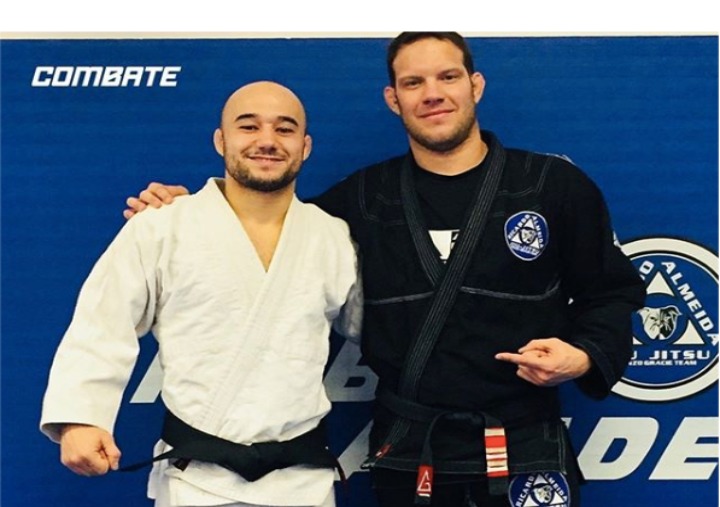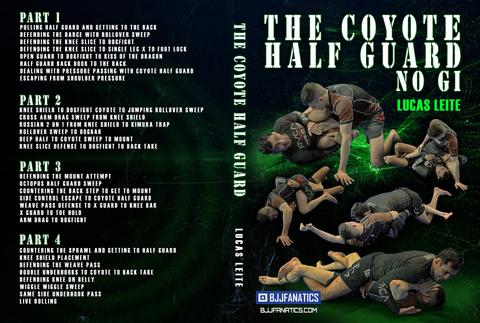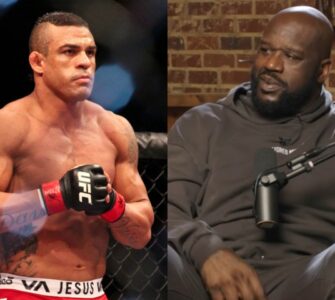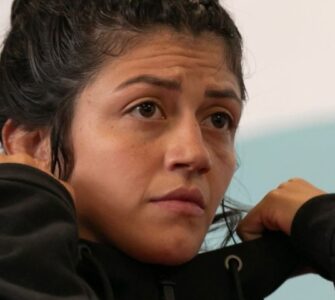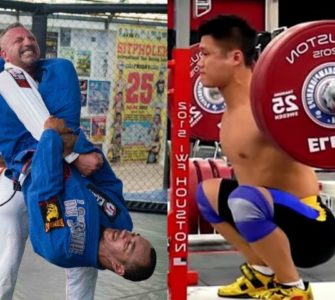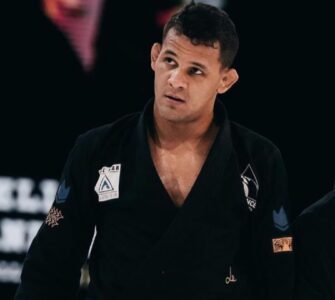Ricardo Almeida is the first student that Renzo Gracie promoted to the rank of black belt, and he’s also one of the veterans from the 2000’s era of MMA. He competed in numerous grappling matches, becoming a widely recognizable name in the BJJ community.
But it’s not just about his successes as a competitor. He is nowadays a head instructor of the successful Ricardo Almeida BJJ Academy, where he – by his own words – does something that he loves to do and is loved for what he does.
In this interview with us, he has shared some unique experiences and viewpoints that are guaranteed to make you laugh and understand more about the beautiful game and origins of the BJJ spirit.
BJJEE: Ricardo, thank you for being a part of this interview. You have an interesting nickname, „Cachorrão“, meaning „Big Dog“ in Portuguese. Could you tell our readers the story behind how you got it?
Ricardo: Man, it’s a long story, it’s from before I did jiu jitsu. I used to live right by the beach, and somehow, this beach was like a surfing beach. Pretty much, we had a bunch of kids from our neighbourhood and I was always involved with everything we did. If we organized soccer games, when we went over to a couple of beaches to play against the kids from the other streets – and when we held little surfing contests, I helped organize them. And the Big Dog, Cachorrão, was like a soap opera character at the time. And this guy was like a… You could say a mobster (laughs), but he kind of helped organize everything.
So, the lifeguards from my beach gave me that nickname. Also, whenever the waves were pretty big, I was probably like the only kid out in the water, the only teenager in the water, whereas the others were adults. It was kind of a hierarchy thing that came out of surfing at the time, I think.
And when I started training jiu jitsu, a lot of people knew me from surfing, so the nickname stayed on the mats.
BJJEE: So, you’ve preserved your nickname when you started training BJJ. But, how did you get into BJJ initially? Also, what made you stay – what made you fall in love with our sport?
Ricardo: I think that, when I was around 14-15 years old, growing up in Rio – and, especially back in the day – there were a lot of fights. And I got to the age where I was going out on my own and with my friends, so my dad wanted to make sure that my brother Flavio and I could handle those things. And he has trained karate, so I just started training karate as well.
I think I did karate for like 6 months or something like that. And I had a friend, Marcelo, who runs Gracie Barra in Australia, with whom I went to school together from first grade, through the middle school, all the way up to high school – all the time being in the same class. And he started doing jiu jitsu at around the same time I started doing karate, and after a few months he finally got me to try the jiu jitsu class. Marcelo was like: „Come on, Ricardo, you have to come and give it a try!“ And the first time I got onto the mats, I just fell in love with it.
I fell in love with just how cerebral jiu jitsu is, with all of the options available. With the physical aspect of it, with just being able to get in there and just go to war with somebody… The competitive aspect of it, you know? Also, the comradery, like the environment that I found on the mats, it was like nothing I ever experienced.
Somehow, it was a little like surfing. You know, people would come in from all walks of life and would join the surfing lineup. And there was a clear pecking order back then, you know. You weren’t supposed to take waves from other people. Like, who of the guys gets to go to the biggest waves? That would be the guy who is the best surfer.
And jiu jitsu was a little bit like that. But, what struck me the most was just how welcoming the people were – but also how tough they were, in terms of their discipline and not taking crap from other people. So, I think that I was immediately attracted by the physical aspect of jiu jitsu when I was young, when I was around 15-16 years old. That definitely threw me into the competitive aspect of it. But, I think that more than anything, that the comradery, the brotherhood, the clear culture that we had on the mats… That was unlike anything else.
When I started training, master Carlos was the only black belt at Gracie Barra, and Renzo was the black belt. And all the other guys were brown belts, a lot of other guys were purple belts, and many guys were blue belts. And as a teenager, I was too big to train with the kids, so I ended up being in an adult class. It was a very, very cool experience for me, to be a teenager surrounded by all the adults that trained there.
So, I immediately fell in love, went home and started drilling moves with my brother on our carpet… Getting carpet burns. (Laughs) And I brought him to train with me and he brought a bunch of friends to train as well. So, a lot of kids that we grew up together with – having played soccer with them on the street, flying kites – they all became black belts at Gracie Barra, which is really cool.
BJJEE: You also have a really cool story about how you got into MMA. In 2000, you were cornering Ryan Gracie in Japan, when one of the fighters pulled out of the tournament because of an injury. And you basically got offered to fight instead of that fighter – you took your chance and won!
How did it feel like to win this fight, were you nervous a lot?
Ricardo: Yeah, so me getting started in MMA was totally unexpected. I never really had any dreams of becoming a fighter, I just wanted to compete.
I think I won Nationals as a blue, purple and brown belt. And then I started doing the local NAGA’s, going into the Grappler’s Quest, superfights, and then the first ADCC’s came around… And, back then, it started happening every year. I just kind of started focusing on that.
And in 2000, Ryan was coming here really frequently. He started fighting in Japan and he was going to fight Sakuraba. He asked me to go with him.
So, we spent two weeks training in Japan. Rickson was actually there, coming for a couple of days to train. And that was a very, very unique and definitely memorable experience to be with Rickson, to just hear him talk. To hear all those ideas on training and fighting… It was definitely something else. You hang out with Rickson, you always get this feeling that he knows something you don’t and that you will probably never know. He has figured some things out that I think other people never will.
And yeah, so some Brazilian guy, I think, was supposed to fight Akira Shoji and he got hurt. And they needed somebody to fill in, and they wanted to call Niño to do it at the time. He was already training in Brazil. But I was like: „No, I’ll do it, I am already here.“ I really had no idea what I was getting myself into. I just saw it as one more competition.
So I never did any sparring. All that I knew was, like, how to throw a jab and a leg kick – and that is, kind of, how the fight went.
Like, I couldn’t take Akira Shoji down, so I ended up being taller, just using my jab and leg kicks in two ten-minute rounds. I pretty much had no idea what I was doing – it was beginner’s luck.
You know, in Portuguese we say that „God always protects children“, you know. It’s kind of like, when you don’t know what you’re getting yourself into, a lot of the times things will be easier. But sure, I have been training for a couple of years and I have been around fighting, so it wasn’t as if I was a total beginner. But, I truly did not know how to throw punches, especially in comparison to the level that I see our guys – like Frankie and Eddie – like they do it nowadays. I was a beginner in everything but jiu jitsu.
BJJEE: You’ve retired from competing in MMA in two instances; first in 2004 and then in 2011 – in both cases because you wanted to spend more time with your family and to focus more on teaching BJJ.
Could you tell us a little bit about that period? Was it difficult to stop competing, or were your priorities always more oriented towards your family and teaching?
Ricardo: To me, competing has always been about being the best. Or… Maybe not even about being the best, because nobody really is „the best“, you are simply the best in some individual contest.
So, to me, it was always about winning. About being the best at whichever level you are at. So, coming up in Rio, it was about me being the state champ and me winning the local tournaments. Then, the national competitions started and I competed and won the first Nationals before the IBJJF was created… I was something like a junior blue belt, 16-17 year old, when I won that.
So, when I was fighting in MMA, it was about being the best in the world or winning the belt in the organization that I was fighting in at that time. I did that in Japan, fighting at Pancrase. I fought a couple of fights in PRIDE at the time when they didn’t have the belt.
And so my kids were born at the time. So, the first time I retired was when my kids were born. And MMA, at that time, was kind of like in a limbo. The UFC wasn’t really big back then, and I was tired of fighting in Japan. Plus, the pay wasn’t really enough. I thought: „Man, if I keep fighting I will never be able to provide for my family“, you know?
And so it was easy for me to focus on my school, on jiu jitsu. I knew that I could make a good living with it, you know – by doing something that I loved and with the people that loved what I do. To live a lifestyle that was happy, healthy… For me, it was a no-brainer.
I mean, at the level I competed back then, I had nothing more to prove. I actually think that they had some ranking system back then, and I was ranked number two. Then, only later did the UFC started getting bigger and it was when I was still pretty young, being thirty-something years old. I wanted to give it a go, I felt that I had a little bit more to give.
And so I started fighting, getting really close to getting a title shot. And then I lost, by split decision… I kind of dropped to 170lbs then, and had a couple of fights, and I got really close and then lost a match. I was like – man, I’m gonna need 4 to 5 more matches in order to fight for the title again. So, it was easy for me to walk away.
I fought to be a champion. Nothing else. I always knew that I wanted to become an instructor, to see my school and students grow. I saw it as a way of making a living. And so, to me it was easy to walk away.
Even today, sometimes, guys are like: „Man, are you feeling like fighting again? You should fight at the ONE Championship.“ And as I still have that competitive fire in me, I still do the nogi Pans almost every year… This year I will try to do the nogi Pans and the nogi Worlds. But, yeah, I don’t know about fighting again. I’ve done it already, you know? I don’t see why I should go back and do it all over again, when I’ve already done it.
Sometimes I even question myself doing the jiu jitsu competitions. I mean – how many times can you do the same tournament? How many times can you go and do the same thing? And honestly, I am most likely going to do it this year. Because, if I don’t do a tournament, I tend to start not paying enough attention to my training. So I do it every year in order to get into a little bit of a better shape, to motivate my students.
But, yeah. For me, it was always easy to walk away from competing – because I’ve given it everything I got at the times I did it. Sometimes I came up on top and sometimes I came up short… I have two silvers from the ADCC’s; one time I lost by one score when I was a brown belt, when I got my guard passed. And the other time, to the minus one rule that they have on the ADCC’s, it was a great match – I came up short.
So, looking at it – do I wish I could go back and do it all over again? Yeah. But I can’t, and I gave it my all. I’ve rolled the dice and the score card showed what happened, and I’m content with that, you know?
Do I wish that certain wins had happened? For sure, but that is not going to make me go back now. I’m in a different place in my life right now and I’m helping a lot of people, it is not only about me anymore.
BJJEE: Thank you. Now, in the period after returning from your first retirement, you were carrying a back injury that made you incapable of training as hard.
Do you remember, how have you carried yourself mentally through this injury – and the other ones? What is your mindset in regards to injuries, could you share it with us?
Ricardo: I think that the injury I had was a sports related hernia, actually, not a back injury… I can’t really remember, it was like 10 years ago now. But yeah, I think that that was the one that sidelined me the longest, I think I wasn’t able to fight for about a year… The best way to cure an injury is to get another one. (Laughs)
But yeah, sometimes there are debilitating injuries, but I’ve never had anything too major. I’ve had a knee surgery which was nothing too major, the sports hernia… I’ve battled shoulder inflammation, something like arthritis, for a while. But I’ve never gotten anything too major as far as the functionality of my body is concerned.
Yeah, you get your tooth knocked out and all of these things in fighting, but nothing crazy.
I think you just have to be patient with the injuries, you have to give yourself time. Yeah, some days are more painful than others, but you should just get back to work and get used to the pain. You need to work on the function and stability of the inflicted joint, to manage the injury – to train around it.
I think that one of the best things today in training is that there was a big evolution in it; there are so many different ways to train your body, very specifically around injuries. So I think, instead of just resting and doing nothing, that movement of any kind will get your blood flow moving, which will aid your recovery. Plus, there’s the positive energy that you get from moving your body… The sitting and doing nothing has always been my hardest thing to do. You should try to work around an injury.
You know, sometimes when we get injured doing jiu jitsu and then we can’t do jiu jitsu because of the injury, we start going crazy. But you could still do other things.
If it is an upper body injury, you can get on a bike, on an elliptical, you could do some pool work. If it is a lower body injury, depending on how bad the injury is, you can still ride the bike softly perhaps. Or you can go swimming. Whatever it is, just find a way to work around it and improve the process of healing of the injury.
BJJEE: Now, onto a little bit lighter topics. What are some of your favourite memories that you have of your times on the mats? Maybe some funny or exciting stories that you’d have time to share?
Ricardo: Oh man, I have so many stories… But, one that I remember clearly was the very beginning one in Gracie Barra. I must have been like 16 or 17 back then, and master Carlos was always like… You know, I think he spent his free time watching epic movies. I can guarantee that his favourite movies are the ones like the „Samurai“, the „Gladiator“… All his free time was spent on epic fighting.
And one day, he came up with this idea that two teenagers could easily beat up a high level guy. And this was back then when, you know, a guy being a brown belt was looked at in the same way as a guy that is a world champion is looked at now.
So, he came up with this strategy that he will take two young teenagers, that are really skinny, something like featherweights, against a big purple or brown belt. He told one of the guys to slap this higher level guy in the face, and told the other guy to shoot and take him down on the ground.
So they did this, and they got the guy finished in less than a minute. And from that point on whenever a more advanced guy would come in, master Carlos would challenge him; telling him that two featherweight kids could beat him.
From that point on, the thing started escalating. There were soon, like, 10 on 10 grappling matches, but without striking allowed and similar stuff. But then, one day, we were doing all these drills, and we knew that the next fricking high level guy that shows up will be challenged by master Carlos, and all of us kids were looking forward to it.
And Gracie Barra had this gate, that was a sliding gate… When the gate opened, it was Renzo and Ryan, they’re walking in! (Laughs) And we are all looking at master Carlos, and we all looked at each other, and that gate was the only way in or out of the place! So all of the kids started getting out of the windows, running outside, because they don’t want to go against Renzo and Ryan. We thought that Ryan was going to kill us, one by one. (Laughs)
Everybody started laughing, and Renzo was just standing there, looking at us confused – like, why are all of these kids running away from us? (Laughs)
I think that all of the kids respected Renzo and Ryan so much and that they wouldn’t have done it anyway, but they were all running around and down the stairs… I can’t really remember what happened afterwards, but I just remember those Carlos’s epic battles and movie ideas. He’s always been a really, really interesting guy.
BJJEE: What a memory, beautiful! And what about a favourite submission? Do you have one? Why?
Ricardo: My favourite submission, by far, is the arm in guillotine. For one, it is a choke – and the chokes are incontestable. With the armbars, for example, their arm will hurt or break if they don’t want to tap. But, with the choke they go unconscious… There’s a finality to a choke that I don’t think exists with joint locks.
I mean, yeah, of course, you can heel hook someone and they will not be able to walk. But, sometimes they escape, sometimes they would „eat it“, but with the choke, once you get it – that is a checkmate.
To me, there’s definitely no clearer checkmate in grappling than the choke. And the reason that I love the guillotine is that it is the only submission that can be used in all of the phases of fighting.
You could be standing and use the guillotine, you could be on the ground and use the guillotine, it can be used in the transition from the feet to the floor. It can be used during the „get up“, when you transition from being on the floor back to your feet. On the ground, you can use it from the bottom and from the top. From the side…
The high elbow guillotine you can also use, of course, but I favour the arm in guillotine because the arm control is the best control. And I think that the only weakness of the arm in guillotine is that it is typically very hard to use in the gi. But, since I don’t do gi competitions, I don’t worry too much about it. (Laughs)
But, yeah. To me, the most versatile and the best submission is the arm in guillotine. No doubt.
BJJEE: Awesome, that is a really interesting insight! To conclude our interview, do you have any advice that you would like to share with our readers that want to become the best jiujiteiros that they can? What can they do to improve themselves as much as possible?
Ricardo: So, I’ll give one version that is more for the recreational and the other one for the more competition-driven guys.
If I had to do it all over again, in regards to the competition, I would definitely – when I was a blue belt – I would just try to compete every weekend. I would go from the Saturday’s competition to a Sunday open mat session and review things. These open mat sessions can be used really well for getting your blood flow going after matches, and you should try to get your training during the week into a form that will help your progress.
Probably, most of my training would involve building blocks, such as strength training, stability training, mobility training, endurance training – including aerobic and anaerobic exercises. So, that would mean sprints and long runs, or interval training and long cardio.
And as far as mats are considered, I would just do a lot of drilling and specific rounds, starting from the feet on the last hard training day prior to competition weekend day. I would just be on the mats every weekend competing, gi or nogi, day in and day out, in my weight and open weight… For the lighter guys, of course, it is more difficult to get into the open weight, but it still stands that they should get as many matches as possible.
You know, accumulate over a 100 matches in a year and let that accumulate over a 4-5 year period. I think that, for the competitors, this is the best way to go about it. And I think that that intensity of training would be something I’d try to replicate if I was going into it all over again in the current competitive environment.
And as for the recreational practitioner, man, you’ve got kids, you have a job… If you had building blocks consisting out of one aerobic and an another day with an anaerobic phase, and with a little bit of strength, mobility and flexibility training, those would 100% help on the mat.
But, as far as the mat days are considered, if you can start going – maybe after you get your blue belt – from two to three, maybe even four days a week, that would really, really help out a lot.
But, hey. Especially as we get older, I think that strength training, flexibility and mobility, as well as aerobic and anaerobic endurance training, really become super important building blocks for high performance on the mats. I feel that now, I’m about to be 43 in November, you know.
And as far as the other tips are considered… As far as the longevity of training and things like that, which are more theoretical in nature, I think that no matter who your instructor is, the first rule is to just be a good student. To listen to your instructor and to not follow people blindly.
Like, if your school has a cult-like environment, you shouldn’t be there in the first place. Find a clean school, a cool environment where people are supportive of each other.
I mean, it’s not like a fight club, it should be a place where everybody supports each other. And I know that that sort of a place is difficult to find, but… You can even be a recreational practitioner in an all-competitive school! I am sure that the competitive guys would look at you and be like: „Man, this guy trains only two days a week, he’s so tough!“ They’re going to be supportive of you any way around.
I see that now, with the advance of technology, guys go online and learn a couple of leglocks from John Danaher, and some half guard tips from Bernardo Faria. And then they look at some wrestling videos for learning takedowns, and that is all great but… At the end of the day, you still need a professor. You still need a professor that has kind of „seen it all“ and that will help you put it all together. So, having someone along side you on a daily basis, with experience and someone who has seen a ton of people go from white to black belts, and that can give you tips – I think that that is really the key.
I mean, it doesn’t matter who he is. If the guy is a black belt in jiu jitsu, man, I don’t think you can go wrong by following everything he did. And then, once you get to a certain level and you want to learn something else, I’m certain that the instructor will open doors for you. And if he doesn’t, well, maybe just look for a different situation.
Jiu jitsu is an apprenticeship. It is not like a huge college, where you have all these departments. In jiu jitsu, you’re basically learning a craft from someone who makes craftsmen. So, build up your craft under someone else’s craftsmanship, under someone else’s guidance.
I’ve always enjoyed the relationship with my instructors, listening to them and talking to them, much more than them just making me good in jiu jitsu. It is a unique relationship, and I think that for most of us that train jiu jitsu that this is the case.
So, to sum it all up, be consistent on the mats but try to train right and try to go through the building blocks. And just trust your instructor. Like, you need to trust the process blindly sometimes and you need to just keep going. That way, you’ll break through whatever walls or shortcomings you’re coming against on the mats.
And, more than anything, just have fun man. Jiu jitsu is amazing, I’ve never seen people find anywhere else that which we find on the mats.
For The First Time Ever, Lucas Leite Shares His World Famous Coyote Half Guard Adapted For No Gi.
Learn The Weird Techniques that Lucas Leite uses so well against bigger opponent’s that he voluntarily enter tournaments in the ultra-heavy division with an almost 100 lb weight deficit.

